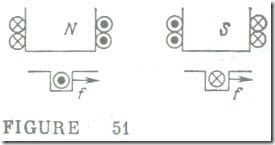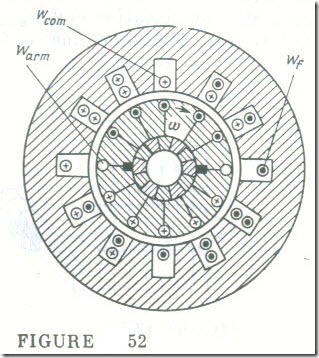A.C. Commutator Machines
A most valuable quality of d.c. motors is that their speed and torque can be controlled gradually and economically. However, on a commercial scale electricity is generated in the a.c. form which has first to be converted to d.c. in order to make it available to d.c. motors. This makes the use of d.c. motors more complicated and costly. It is therefore natural that attempts have been made to use commutator machines directly in a.c. circuits .
If we change the direction of current flow both in the armature and field windings of a d.c. motor, . the direction of its torque will remain unchanged fig. 51 . Therefore, if the direction of the current in the two windings of a d.c. motor were reversed periodically and simultaneously, as would happen if it were connected to an a.c. supply line, the motor will develop some average torque of constant direction. Before, however, a d.c. motor can be connected to an a.c. line,. its design must be adapted to operation in an alternating magnetic field. Among other things, it is necessary to reduce eddy currents 10 the frame as they greatly weaken the main magnetic flux and to reduce the inductance of the armature winding so as to improve the power factor and commutation.
In order to reduce eddy currents, the frame of an a.c. commutator motor is bu.ilt up of electrical-sheet steel laminations (see Fig. 19 b). The inductive reactance of the armature winding warm is reduced by balancing out its magnetic field with a compensating winding which Is spread uniformly all the way round the periphery of the stator and connected in series opposition with the armature (rotor) winding .
A further reduction in the magnetic field around the armature is achieved by using nonsalient-pole stators in a.o. commutator machine. A. nonsalient-pole stator is a hollow cylinder with slots which receive (Fig. 52) the field winding wcom ,and the compole winding (not shown in the figure ) .
It is to be noted that the field ending , too has an inductance, but the magnetic flux set up by this winding is essential for the generation of torque, so it may not be balanced out. In a series motor the inductance of the field winding somewhat impairs the power factor, in a shunt motor the high inductance of the held winding brings about a phase shift of nearly 90" between the excitation flux and the voltage, while the armature current is nearly in phase with the voltage. As a result, the average torque produced by the interaction of the excitation flux and the armature current which are nearly in quadrature with each other would he small. This is the reason why special measures have to be taken in present-day a.c. commutator shunt motors, and their field of application is very limited.
The task of achieving satisfactory commutation in an a.c. commutator motor poses a number of coil being com mutated (see Sec. 13.7), one being the reactance emf, ereac which is the emf of the self-induction and mutual induction, and the other being the commutation emf, ecom, induced as the coil sides cut the .magnetic .field set up by the compoles . This commutation emf, which IS proportional to the armature current, can completely cancel the reactance emf and ensure ideal commutation in which case ereac + ecom = 0 , or even lead to early commutation when ecom > ereac . All this IS utilized in a.c. commutator motors: they are fitted With compoles in the same way as d.c. machines are .
In contrast to a d.c. machine, a third (transformer) emf, et, Is induced in a coil undergoing commutation in an a.c. commutator motor. It owes its origin to the periodic changes in the main magnetic flux threading the coil sides. With respect to the alternating magnetic flux the coil being commutated and short-circuited by a brush acts as the closed secondary winding of a transformer (Fig. 53). This emf may be defined in the same way as the emf on a transformer
et = – wcdΦ/dt
where we is the number of turns in a rotor coil.
The transformer emf lags in phase behind the magnetic flux that induces it, and is in quadrature lagging with the field current. It is independent of the rotor speed and retains its value oven when the rotor is at rest.
The conditions for ideal commutation in the case of an a.c. commutator motor are the same as they are for a d.c. motor, namely the algebraic sum of the emfs in the coil undergoing commutation must be zero. To satisfy this condition, the designer has at his disposal only the commutation emf, ecom. induced by the com poles. Unfortunately, teom is proportional to the rotor speed and is zero at starting.
Therefore the compole flux can be used to create conditions for ideal commutation only at Some definite speed. This is probably the most important limitation of a.c. commutator motors. So, since the presence of et in the coil undergoing commutation is inevitable, the designer can only, firstly, take measures so as to reduce et as much as practicable and, secondly, limit the short-circuit current produced by the emfs in the Coil being commutated.
The rms value of transformer emf, Eq. (7.2c), is
Et = 4.44/wcΦm
Therefore, in order to reduce it, the designer uses fewer turns in each coil of the rotor winding. At the same time, in order to preserve the total number of turns in the rotor winding, he uses a greater number of coils and, in consequence, a greater number of commutator bars. In fact, an oversize commutator is a distinguishing feature of an a.c. commutator motor. Additionally, the designer can reduce the flux Φ m set up by each pole, but in order to preserve the overall flux he has to use a greater number of poles.
A radical way to reduce et is to reduce the supply frequency.
This also entails a reduction in the reactance of the motor. Of course, this measure may only be applied when an a.c , commutator motor operates off an isolated a.c. line. In practice, a reduced frequency (50/3 = 162/3 Hz) is sometimes used in electric traction on a.c.
The short-circuit current appearing in the coil undergoing commutation can be limited by inserting series resistors in the coil circuit (Fig. 13.54). Since the rotor current also flows through these resistors, their resistance ought not to be very high, or else heat losses would be prohibitive. This purpose can alternatively be served by carbon brushes which have a high resistance.



